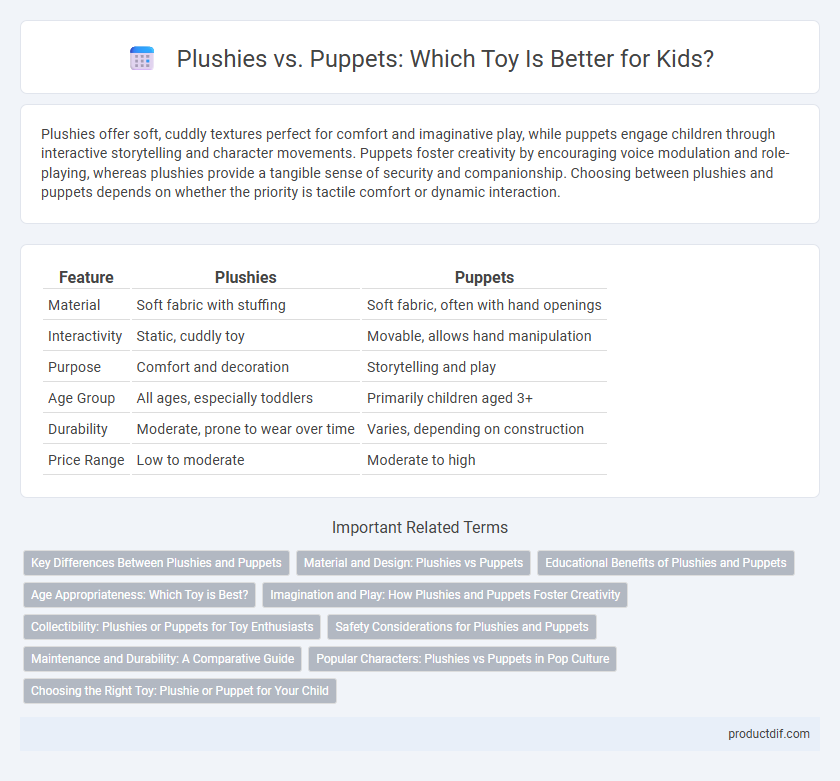Plushies offer soft, cuddly textures perfect for comfort and imaginative play, while puppets engage children through interactive storytelling and character movements. Puppets foster creativity by encouraging voice modulation and role-playing, whereas plushies provide a tangible sense of security and companionship. Choosing between plushies and puppets depends on whether the priority is tactile comfort or dynamic interaction.
Table of Comparison
| Feature | Plushies | Puppets |
|---|---|---|
| Material | Soft fabric with stuffing | Soft fabric, often with hand openings |
| Interactivity | Static, cuddly toy | Movable, allows hand manipulation |
| Purpose | Comfort and decoration | Storytelling and play |
| Age Group | All ages, especially toddlers | Primarily children aged 3+ |
| Durability | Moderate, prone to wear over time | Varies, depending on construction |
| Price Range | Low to moderate | Moderate to high |
Key Differences Between Plushies and Puppets
Plushies are soft, stuffed toys primarily designed for cuddling and comfort, characterized by their stationary features and varied animal or character shapes. Puppets, in contrast, are interactive toys with movable parts controlled by hand or strings, enabling expressive movements and storytelling. The key difference lies in functionality: plushies serve as static companions, while puppets provide dynamic play through manipulation.
Material and Design: Plushies vs Puppets
Plushies are typically made from soft, fluffy fabrics like polyester or fleece, offering a cuddly texture ideal for hugging and comfort. Puppets often utilize sturdier materials such as felt, foam, or fabric with reinforced seams to enable hand manipulation and expressive movements. Plushies focus on a plush, three-dimensional design for huggability, while puppet design prioritizes functionality, with movable parts like mouths and limbs for interactive play.
Educational Benefits of Plushies and Puppets
Plushies promote emotional development and empathy in children by providing comfort and encouraging imaginative play. Puppets enhance communication skills and creativity through interactive storytelling and role-playing activities. Both toys support cognitive growth by fostering language development and social interaction in educational settings.
Age Appropriateness: Which Toy is Best?
Plushies are ideal for infants and toddlers due to their soft, cuddly texture and lack of small parts, making them safe and comforting companions. Puppets, often featuring moving parts for interactive play, are better suited for preschoolers and older children who can actively engage in imaginative storytelling. Age-appropriate selection ensures safety while promoting developmental benefits like sensory skills for plushies and creativity and communication skills for puppets.
Imagination and Play: How Plushies and Puppets Foster Creativity
Plushies and puppets both encourage imaginative play by providing tactile, interactive experiences that spark creativity in children. Plushies offer comfort and role-playing opportunities through their soft textures and endearing designs, inspiring storytelling and emotional connection. Puppets enhance imaginative scenarios by allowing children to control characters and voices, fostering expressive creativity and dynamic social interaction.
Collectibility: Plushies or Puppets for Toy Enthusiasts
Plushies often hold higher collectibility value among toy enthusiasts due to their wide range of licensed characters, limited edition releases, and soft, tactile appeal that encourages display and preservation. Puppets, while popular for interactive play and educational use, typically have a narrower collector market influenced by craftsmanship, brand heritage, and rarity of artisan designs. Collectors prioritize plushies for their extensive variety and market demand, whereas puppets attract niche collectors focused on unique cultural and artistic significance.
Safety Considerations for Plushies and Puppets
Plushies typically feature soft materials and minimal small parts, reducing choking hazards and making them safer for young children. Puppets often include movable components or buttons that require careful inspection for secure attachments to prevent accidental ingestion. Choosing toys made from non-toxic, hypoallergenic fabrics and ensuring compliance with safety standards like ASTM or EN71 enhances protection for both plushies and puppets.
Maintenance and Durability: A Comparative Guide
Plushies require gentle spot cleaning and occasional brushing to maintain softness, while puppets often need more frequent cleaning due to frequent handling and small moving parts susceptible to wear. Durability varies as high-quality puppets are designed for repeated manipulation, whereas plushies rely on dense stitching and strong fabric to resist tearing and maintain shape over time. Choosing between plushies and puppets depends on the intended use, with plushies favored for cuddling and puppets for interactive play, each demanding tailored maintenance to extend lifespan.
Popular Characters: Plushies vs Puppets in Pop Culture
Popular characters in pop culture often appear as plushies and puppets, each offering unique appeal to fans and collectors. Plushies like Pikachu and Totoro provide a soft, cuddly representation ideal for display and comfort, while puppets such as Kermit the Frog and Elmo bring interactive, performative experiences through storytelling and play. The choice between plushies and puppets reflects different engagement styles with beloved characters, blending tactile enjoyment and imaginative interaction.
Choosing the Right Toy: Plushie or Puppet for Your Child
Plushies offer soft textures and cuddly companionship, making them ideal for comfort and imaginative play, while puppets encourage interactive storytelling and develop communication skills through role-playing. Selecting the right toy depends on your child's interests and developmental needs, with plushies suited for soothing and tactile engagement, and puppets fostering creativity and social interaction. Considering factors like age, sensory preferences, and learning goals will help determine whether a plushie or puppet provides the most enriching experience.
Plushies vs Puppets Infographic

 productdif.com
productdif.com